Thus far we have looked at pleasure gardens in the domus and villa. In this chapter we take up the gardens that supported the economy and daily life. We begin first with kitchen gardens, then the larger produce gardens – vineyards, orchards, and commercial flower gardens – examining the evidence for each type of garden in the Vesuvian sites, elsewhere in Italy, and throughout the provinces. We note both the archaeological evidence and the information in the literary sources. The most detailed discussions are found in the agricultural manuals of Cato, Varro, and Columella, and Pliny the Elder’s Natural History. The oldest of the three agricultural manuals, the De agricultura written by the farmer-statesman Cato (234–149 BC), is a loosely organized series of shrewd and pithy comments, based on practical experience. Varro (116–27 BC), known as Rome’s greatest scholar, began his De re rustica, a longer and more polished work, when he was eighty years old, as a practical manual for his wife Fundania, who had just bought a farm. The longest and most comprehensive of the agricultural manuals was written by Columella, a native of a municipium in southern Spain (present-day Cádiz), who lived in the first century AD.
Kitchen Gardens
The kitchen garden was crucial to the ancient Romans, for fruits and vegetables were an important part of their diet. Cato, Pliny, and Columella discuss the siting, planting, and cultivation of the kitchen garden, listing in detail the plants to be raised. Columella devotes the whole of Book 10 to the kitchen garden, writing it in verse, as an addition to Vergil’s Georgics, which does not mention kitchen gardens. Columella discusses the proper soil and irrigation, and gives advice on digging, manuring, and laying out the various beds. He then names sixty plants, including many herbs, that should be planted. The second half of Book 11 is a calendar of activities for the husbandman, giving considerable attention to work in the kitchen garden, which was labor intensive and thus should be located conveniently near the house with a nearby source of water. Kitchen gardens were meant to support the family not only for their own sustenance but also for profit. A kitchen garden large enough for a surplus of fruits and vegetables could be a source of revenue, particularly if close to a town. In addition, Cato stresses the advantage of growing flowers, naming many that should be planted, to be sold for garlands.1 Indeed, Pliny the Younger mentions two well-stocked kitchen gardens at his Laurentine villa.2
At Pompeii we fortunately have archaeological evidence for actual kitchen gardens. The earliest one identified was in the House of Pansa (VI.4,)3 excavated in the early nineteenth century. A plan shows a large rear garden systematically laid out in rectangular plots separated by paths approximately 2.5 meters wide, which also served as irrigation channels (Figure 4.1). The water reservoir in the north corner was surely used to support the garden. It is laid out in precisely the way Pliny recommends for a kitchen garden – plots bordered with sloping banks and surrounded “with a furrowed path to afford access for a man and a channel for irrigation.”4 Columella gives a more poetic description:
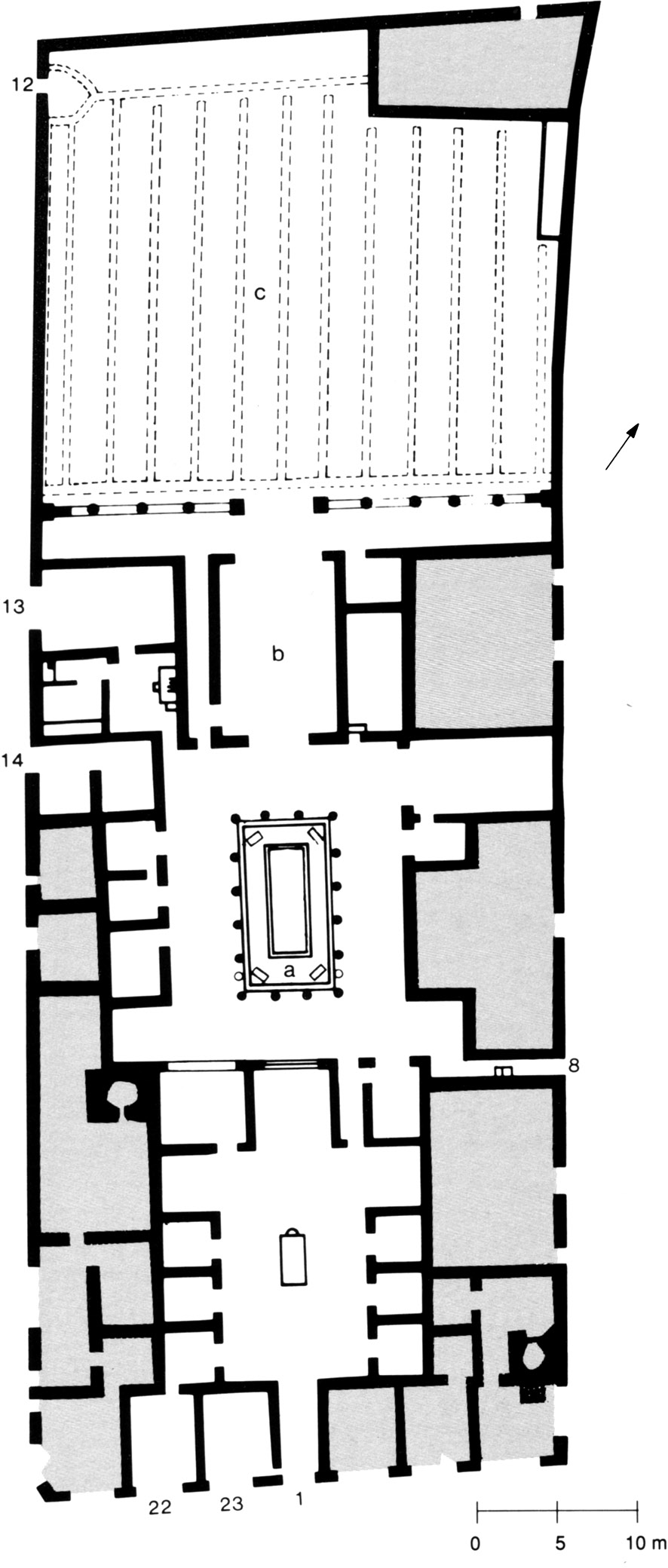
Figure 4.1 House of Pansa, VI.6, Pompeii, plan 44, Jashemski Reference Jashemski1993.
The large vegetable garden at the rear of the house of M. Epidius Rufus (IX.1.20/30) on the Via dell’Abbondanza at Pompeii was laid out in similar fashion with paths the same width (2.5 m) as in the garden house of Pansa.6 Maiuri also identified a kitchen garden in the House of the Menander (I.10.4).7
I excavated two smaller kitchen gardens in the lower garden in the House of the Ship Europa (I.15) at Pompeii,8 also laid out in furrows separated by irrigation channels. The roots of vegetables were too small to leave cavities, but a variety of vegetables were likely to have been grown. There were preserved, however, twenty-two irregularly spaced root cavities of small trees. Although trees in kitchen gardens are not mentioned by ancient writers, they may have been common, just as they are in kitchen gardens of modern Pompeii, which are laid out exactly as ancient ones.
I also excavated a small kitchen garden in the villa rustica at Boscoreale in the Località Villa Regina.9 It was located near the farmhouse, to the right of the main entrance. A cistern in the middle of the garden provided the necessary water, as Pliny recommended. The garden was divided into small plots, which were separated by irrigation channels that served as paths.
Two kitchen gardens were found at the villa at Settefinestre, north of Rome – one, on the lower terrace, identified by its furrows.10 A second kitchen garden, surrounded by a rectangular wall, was found next to the turreted garden. It was irrigated by rainwater distributed in channels from the upper garden.
Evidence for the specific form of gardens in the provinces is still very limited, although the archaeobotanical evidence is growing rapidly. Knörzer, after analyzing plant remains from wells, latrines, pits, and other contexts in various villae rusticae in the Lower Rhine region in Germany, was able to identify many vegetables and herbs that might have grown in kitchen gardens. Most of these plants first appear in the archaeobotanical records of the Lower Rhine region in Roman times.11 An area in the villa rustica at Wiesbaden-Biebrich, Germany has been interpreted by the excavators as a kitchen garden.12 Other examples are in a villa rustica in Voerendaal in the Netherlands and at a farmhouse in Wetter Bad, Germany.13 In a corridor house at Carnuntum, in the Roman province of Pannonia (modern Austria), the open courtyard at the back of the house may have been a kitchen garden.14 “The fine garden soil” in an area at a corridor house at Winden am See in Pannonia has been identified as probably a kitchen garden.15
At the palatial Roman villa in Fishbourne, England, the convenient location, soil, and water supply suggest a kitchen garden was located in the external angle between the west and north wings.16 At Bancroft Villa in Milton Keynes, Buckingham, enclosures attached to farm buildings “have yielded plant remains suggestive of kitchen gardens.”17 There is also evidence for a kitchen garden in the nearby farmstead at Wavendon Gate.18 Areas at the Roman villa at Darenth, in Kent, the villa at Frocester Court, and at a country house in Latimer have been interpreted as kitchen gardens.19 Along the northern border of Britannia, soldiers grew fresh vegetables in small gardens at Wallsend and Housesteads on Hadrian’s Wall, and at Croy Hill and Rough Castle on the Antonine Wall.20 These gardens were small irregular plots located outside the walls of the forts.21
Most of the forty squares in the rustic pictorial mosaic calendar from Saint-Romain-en-Gal, now in the Musée de Saint-Romain-en-Laye, depict gardening and viticulture. One pictures workmen sowing, probably beans, in a kitchen garden (Figure 4.2). Many other mosaics picturing gardening and viticulture are found in this area famous for its gardens and vineyards.

Figure 4.2 Workers sowing, Saint-Romain-en-Gal, detail of mosaic floor, now located in the Musée de Saint-Romain-en-Laye.
Moving to the Eastern Desert of Egypt, archaeobotanists working at Roman Berenike, an important trade port on the Red Sea coast in southeast Egypt, and at Shenshef, a nearby mountain village, report there were kitchen gardens at these ancient sites. Many of the plants identified among the excavated vegetal material would have been grown in a kitchen garden. The kitchen produce from Berenike is extensive and includes plants well known in the Mediterranean: garlic, almond, apricot, caper, carob, chick pea, coriander, hazel, cucumber, fig, fennel, barley, date palm, walnut, lentil, flax, olive, umbrella pine, plum, peach, vetch, faba, and other varieties of bean. The site also gives insight into plants of the region, as well as exotic plants grown there, if not widely elsewhere. René Cappers22 gives extensive treatment to the presence of the coconut palm and black pepper, beet, saffron, and mangrove. The rosary pea (Abrus precatorius), however, being poisonous, must have been purely decorative.23 Nile Acacia (Acacia Nilotica) produces a reddish gum and large pods, both of which were used for tanning and dyeing.24 Another kind of local acacia, twisted acacia (Acacia tortilis), identified among the plant remains, was used for fencing of gardens.25
Similarly, at the Roman quarry site of Mons Claudianus archaeobotanical research, together with texts written on ostraca, show conclusively that kitchen gardens provided fresh vegetables to the mining community there, particularly cabbage, beet, lettuce, chicory, cress, mustard, asparagus, and turnip. Despite the harsh desert conditions, wells provided water and the community ate a wide variety of grains, legumes, fruits, and vegetables. Sidebotham reports the remains of a garden at Sikai.26 There plants were grown in dozens of small stone boxes, without bottoms, which were set in the ground. Dessicated roots were found in some boxes, though identification was not possible. Impressions in concrete suggest that pipes brought water to these boxes.
Kitchen gardens were at times attached to tombs.27 Although the archaeological evidence for kitchen gardens at tombs in Italy is meager outside of the Vesuvian sites, the information about the vegetables and flowers to be raised in the kitchen garden found in Pliny’s Natural History and in the three agricultural writers reflects in general what would be raised in a good part of Italy. Greek papyri document intensively productive gardens in the Alexandrian Necropolis of Egypt.28
Vineyards
The economic value of the grape for use in winemaking was discovered over two thousand years before the Romans developed their own viticulture. Asia Minor, the Levant, Greece, and North Africa all had well-developed economies in the growth of grapes and the trade of wine by the time of Roman conquest. Abundant archaeological remains, from wine presses, tools, and artistic representations to the carbonized and mineralized remains of grape pips, support the many references from ancient texts. However, few archaeological remains of the vineyards themselves have been identified.
Because of the way the Campanian sites were preserved by the eruption of Vesuvius, our most detailed information about Roman vineyards comes from this area. The many vineyards that I have excavated give us detailed information about Roman viticulture. All but one of these vineyards are located within the city walls of Pompeii, attached to houses, and they were of various types. The casts that we made of the ancient roots reveal not only their actual size but also the planting pattern. We found a large, formally laid out, commercial vineyard and some of a less formal nature. The countryside was dotted with vineyards. The grape was a major part of the Italian economy, but the vineyard at the villa rustica at Boscoreale is the only villa vineyard that has been excavated.
The large city block (II.5) across from the amphitheater at Pompeii had been known for over two hundred years as the Foro Boario (cattle market). We discovered, however, that it was a large vineyard (Figure 4.3).29 Two paths crossing at right angles divided the vineyard into unequal plots. The reason for this irregular arrangement appears to be because they were laid out with respect to external considerations – the north-south path is on axis with the entrance of the nearby amphitheater, and the east-west path led to a triclinium just outside the door of a building where wine was made. Columella says that vineyards should be divided by footpaths for the use of the laborers in carrying stakes, repairing the frames, and tending the fruit.30 He recommends that vineyards be divided into areas of one-half a iugerum(approximately one-fourth of a hectare), which is approximately the size of each quarter of this Pompeian vineyard.
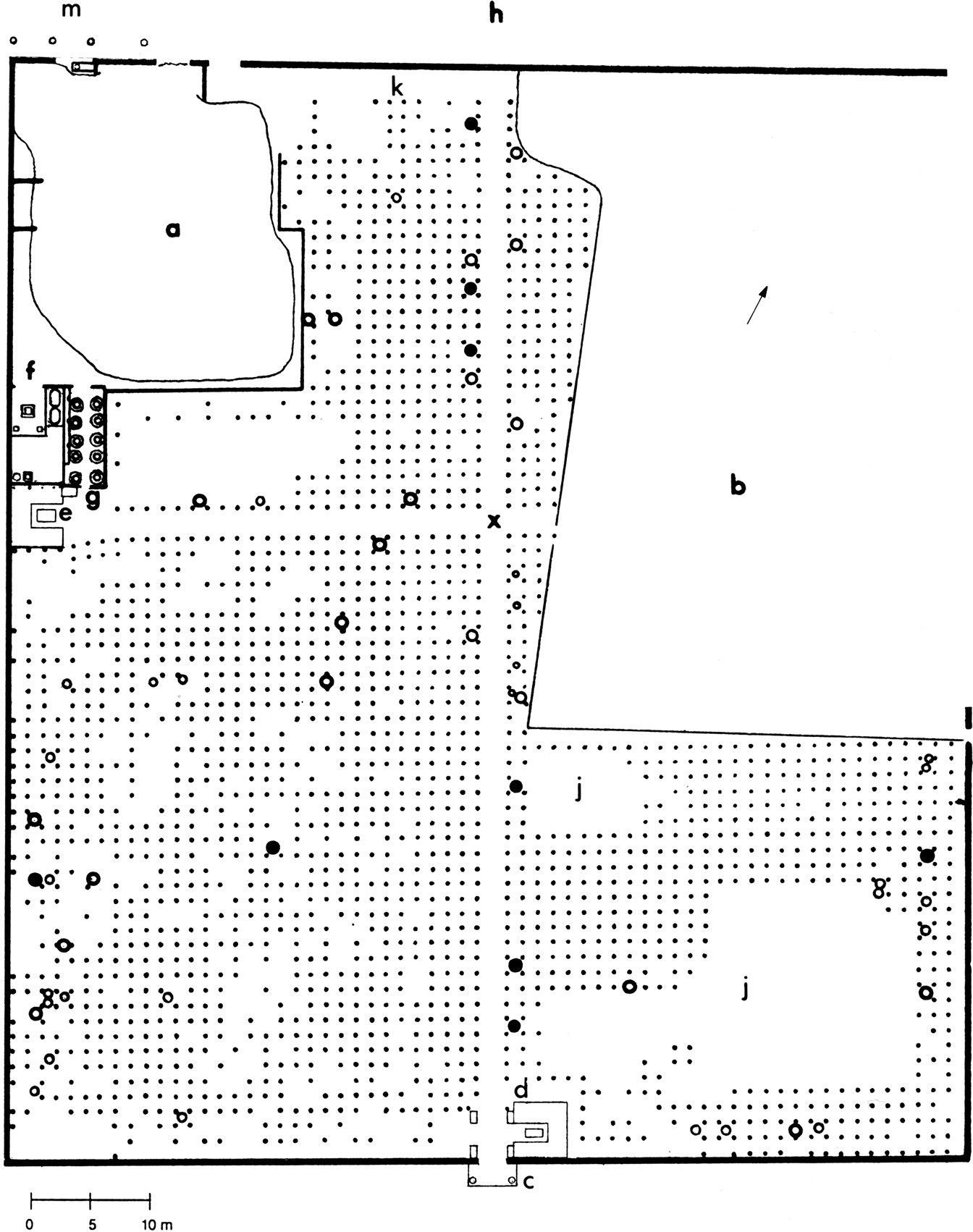
Figure 4.3 Large vineyard, II.5, Pompeii, plan: (a,b) unexcavated areas; (c) entrance; (d,e) triclinia; (x) intersection of paths; small dots indicate grapevine roots; small circles, small tree roots 10 centimeters or less in largest dimension; larger circles, medium tree roots; large dark circles, large tree root cavities 30 centimeters or more in largest dimension, Jashemski Reference Jashemski1993, plan 28, p. 89.
After excavating an actual vineyard, it was of great interest to see the extent to which the proprietor had followed practices recommended in the ancient manuals and to what extent they were applicable to the Pompeii area. We found that the vines in this large vineyard were planted almost exactly four Roman feet apart, indicating they were cultivated by hand. According to Columella, vines should be at least five feet apart if cultivated by hand, at least seven if cultivated by plow and oxen. Pliny was perhaps drawing on his familiarity with this region when he says that in rich soil (such as that of the Vesuvian region) vines should be planted four feet apart.
The planting pattern in this vineyard is strikingly similar to that in vineyards in the Pompeii area today. Even the three or four depressions around each root cavity were recognized by the workmen as similar to the depressions that they put around their own vines to hold water. These depressions as well as the close spacing of the vines further indicated that this vineyard was cultivated by hand. Furthermore, beside each root cavity we found the cavity of a stake (Figure 4.4).
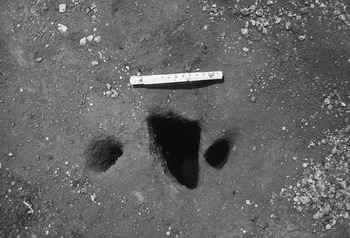
Figure 4.4 Large vineyard, ii.5, Pompeii, cavities left by stake and vine roots.
Along the paths were large cavities of posts (much larger than the stakes in the vineyard) and beside each post the cavities of two vine roots (Figure 4.5A). The nails found near the postholes would have been used to fasten the frames of an arbor-covered passageway, similar to those in vineyards in the Pompeii region today (see Figure 4.5B). The posts and stakes might have been of chestnut, preferred by the ancient as well as modern vintners because of the ease with which it could be worked, its “obstinate durability,” and its resistance to decay.31 Poplar and willow trees were planted in antiquity to furnish withes for tying the vines, as they still are used today (Figure 4.6A; Figure 4.6B).
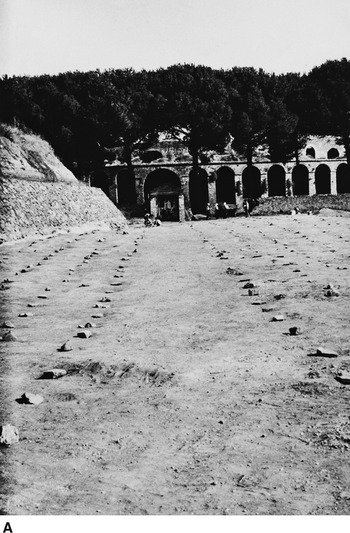
Figure 4.5A Large vineyard, II.5, Pompeii, the north-south pathway leading toward the amphitheater.
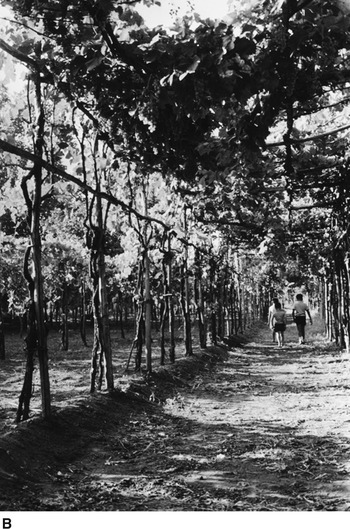
Figure 4.5B Arbor-covered pathway in modern vineyard near Pompeii.

Figure 4.6A Vine tied to a chestnut stake with a willow withe in a modern vineyard near Pompeii.
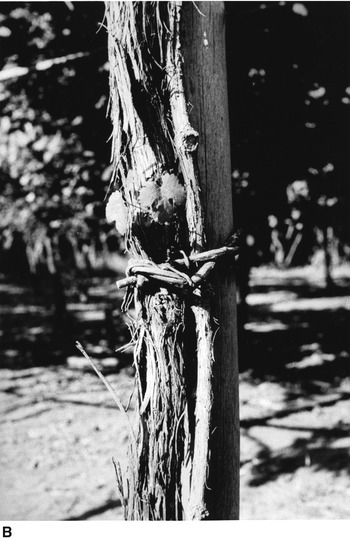
Figure 4.6B Vine tied to a chestnut stake with a poplar withe in a modern vineyard near Pompeii.
The question remains as to how the vines were staked. Pliny lists six methods of training vines (Figure 4.7).32 In the first two methods the vines were not staked – their branches spread out on the ground or they stood alone as a tree, such as those in Spain, which were low growing and without props.33 These methods were not popular in Italy, where vines were staked, propped up with or without a crossbar (Methods 3 and 4). Ancient writers, however, pay little attention to vines with a single stake, but they do recommend yoked vines arranged in rows for cold, rainy areas.

Figure 4.7 Six methods of training vines: (1) Branches spread on ground; (2) Standing alone without support; (3) Propped with stake without support; (4) Propped with support with crossbar (Vitis iugata or canteriata); (5) Trellised with rectangular frame (Vitis compluviata); (6) Wedded to a tree (as in an arbustum).
In the fifth method the vines grew on a trellis with a rectangular frame (Vitis compluviata), which was the system used in this vineyard. Varro and Columella give very specific directions for this method of vine training. Varro34 says vines trellised in a straight line are found in the district of Canusium, but vines yoked lengthways and sideways in the form of a compluvium is the practice generally in Italy. Columella gives detailed instructions for training and pruning vines in this manner.35 Both writers stress the superiority of this method of training vines. Spread out in four directions, the vines not only remain anchored better and are more stable after storms but they also produce the most fruit. In hot, dry areas the shoots filled the frames and formed a roof that shaded the soil. This method is used in the Pompeii area today, but the vines often are not as precisely planted as Columella recommends.
The Pompeians were also familiar with the sixth method of training vines listed by Pliny, wedding them to trees. In Campania vines were often wedded to poplars, as they still are today. Cupids are shown gathering grapes from vines supported by trees in a small painting from the House of the Vettii (Figure 4.8).

Figure 4.8 House of the Vettii, IV.15.1, Pompeii, cupids gathering grapes, fresco after an early twentieth-century postcard, Poligrafico-Napoli.
Columella recommends that the frames should be about five feet above the ground, never more than seven or less than four.36 Varro says the height of the vineyard should not exceed the height of a man.37 According to Pliny, the richer the soil and the more level the ground, the greater the height of the frames required.38
There were also trees in the Foro Boario. We found evidence for at least fifty-eight; there was a row of widely spaced trees around the edges of the vineyard, usually between the second and third row from the wall, a few planted at random throughout the vineyard, and widely spaced trees planted between the first and second rows of vines on each side of the path. This vineyard had far more trees than Columella recommends.39 He says the fig, pear, and apple could be planted, but only at the ends of the rows on the north, where they would not shade the vines. Yet, as our excavations in the Pompeii area have shown, trees were generously planted in vineyards. One modern vineyard we visited, which was much like ours even to the arbored pathway, had thirteen different species of trees. All of them, except the loquat, a modern introduction from Japan, were known to the ancient Pompeians and could have been raised in an ancient vineyard.
Unfortunately, none of the slightly carbonized woody material found in the root cavities in the large vineyard was sufficiently well preserved for identification. We did find, however, two carbonized olives, which may identify one type of tree in the vineyard. The carbonized bean found in the vineyard may indicate intercultivation, a common practice in antiquity and also today. I will never forget my surprise when I first saw a friend’s garden vines growing under trees, and under the vines were corn, tomatoes, beans, and other vegetables. So fertile is the soil, so strong the sun in Campania.
The vineyard had the same equipment for making wine usually found in country villas. The small building in which the wine was made had fittings for a winepress similar to the one that has been restored in the Villa of the Mysteries (Figure 4.9). Two small holes in front of a low barrier held the posts at the end of the windlass used in raising and lowering the press beam. The smaller holes at the back of the room held the stationary part of the press beam.
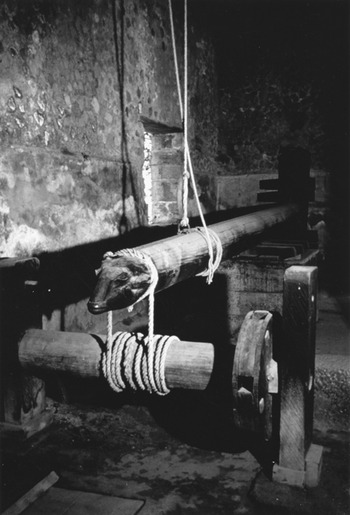
Figure 4.9 Villa of the Mysteries, Pompeii, restored wine press.
The vintner probably did a thriving business serving guests from the amphitheater at two masonry triclinia in the vineyard (see Figure 4.3). We found fifty bones and two teeth nearby. Henry Setzer of the Smithsonian Institution found that eleven bones had cleaver marks, evidence that the bones had been split for marrow, which was considered a delicacy (Figure 4.10). This explained why the early excavators called the site the Foro Boario. They had found bones near the triclinium at the entrance to the vineyard and mistook this area for the Cattle Market.
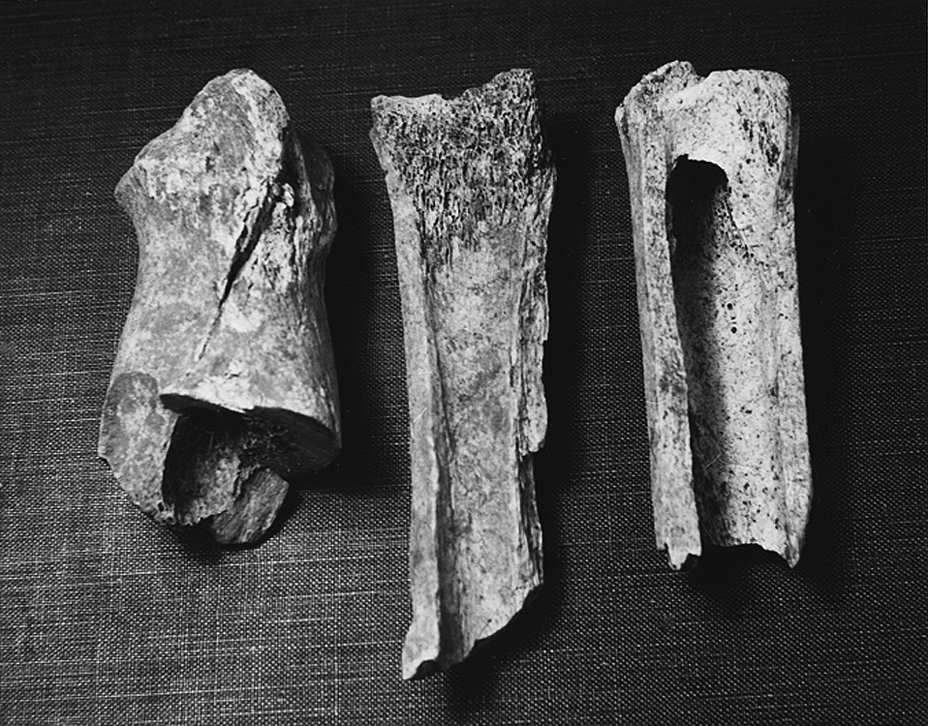
Figure 4.10 Large vineyard, II.5, Pompeii, bones split for marrow found in the vineyard with tool marks visible.
But we were to find other vineyards in the city. A good part of the lower garden in the House of the Ship Europa (I.15)40 was laid out in a vineyard similar to the planting pattern in the large vineyard (II.5). It was precisely planted, the vines four and one-half feet apart (Figure 4.11). This is slightly wider than those in the large vineyard, which were four feet apart, but within the range recommended by the ancient agricultural writers for rich soils. This was a young vineyard, not yet old enough to be staked. The vineyard in III.7 to the north showed a similar planting pattern.41 The root cavities were approximately four Roman feet apart, but they were not as precisely planted as the two previous vineyards. There were trees planted throughout this vineyard.
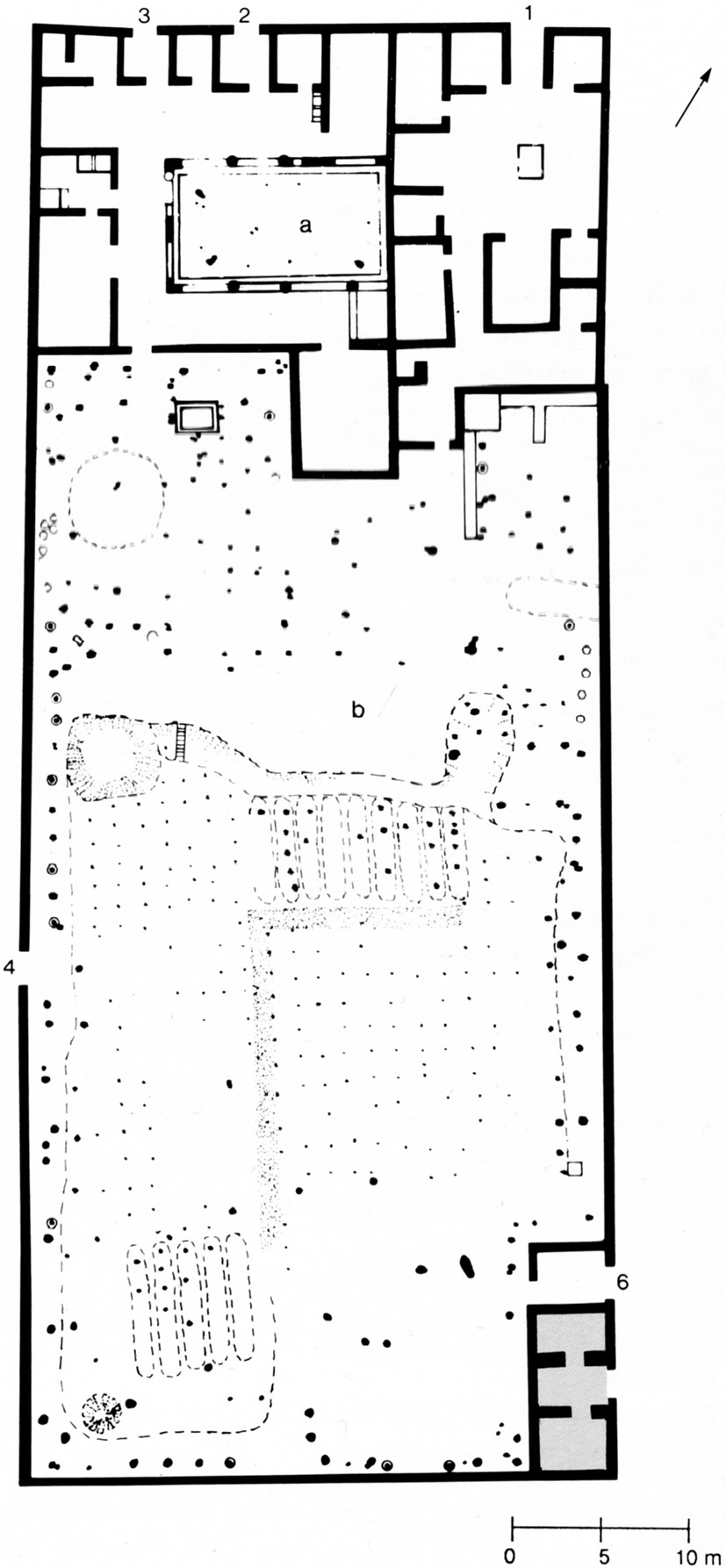
Figure 4.11 House of the Ship Europa, I.15, Pompeii, Jashemski Reference Jashemski1993, plan 18, p. 61.
In the vineyard in the Caupona of the Gladiators (I.20.1) we found that the vines had been very informally planted with one stake for several vines, and also supported by trees, as they often are in vineyards in the area today.42 Here the ripened grapes were trodden by foot in a small building. The ancients maintained that the wine made from juice extracted in this way was much better than that extracted by a press, which bruised the seeds, a belief that my workmen vehemently shared.
In the vineyard to the west of the Great Palaestra (II.9.6) juice was extracted in the same way.43 Built against the front of the house, which had been turned over to winemaking, was a small raised treading floor, where the grapes were pressed by foot (Figures 4.12A; 4.12B). The juice could also be extracted simply by treading on the grapes in a small portable wooden tub. This process, which is pictured on a beautiful blue glass vase found at Pompeii (Figure 4.13), produces exceptionally fine wine and is still used by many who have a limited number of vines.
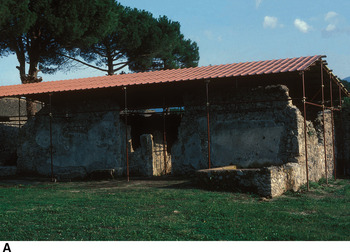
Figure 4.12A House II.9.6, Pompeii, small raised treading floor.
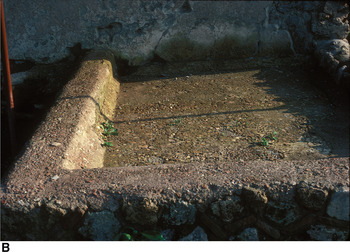
Figure 4.12B House II.9.6, Pompeii, small raised treading floor, detail.
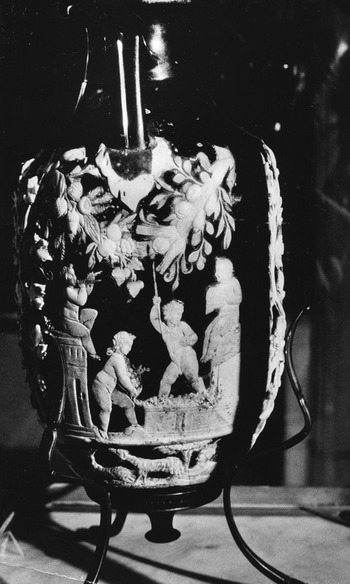
Figure 4.13 Blue glass vase from Pompeii, National Archaeological Museum, Naples, inv. no. 13521.
We have knowledge of over forty villas on the slopes of Vesuvius. These were hurriedly and partially excavated and then covered over again, so the valuable land could be returned to cultivation. The wine and oil presses found in these villas indicate that the land had been mostly devoted to vineyards and olives.44 The vineyard at the villa rustica at Boscoreale in the Località Villa Regina is the first vineyard associated with a villa to have been excavated.45 The vines were informally supported by both stakes and trees. Here we found thirty-four tree-root cavities, most of them in the vineyard. The carbonized olives and almonds found in the vineyard probably identify some of the trees; carbonized grapes were also found.46
We depend largely on the written sources and the inscriptions that have survived on wine jars and amphoras for information about vineyards outside the Vesuvian area. For example, Elizabeth Tydings Will reports that she has found Pompeian amphoras in India.47 Pliny says that of the eighty notable wines in the whole world two-thirds were produced in Italy, listing Italian wines in order of their excellence, and giving a good picture of the location of vineyards throughout the peninsula.48
Our best archaeological evidence for the production of wine and olive oils outside the Vesuvian area is the villa of Settefinestre, to the north of Rome. These have not been excavated, but the processing areas with their basins, presses, and dolia have enabled the excavators to determine that grapes and olives, as well as grain, represented the principal productive crops of this villa.49 The air photographs taken in Apulia by John Bradford during the Second World War are a valuable source about the location of vineyards in this area, for they reveal trenches for vineyards.50
Columella points out that the vine could grow in almost every country, except where there were extremes of heat or cold.51 It can thrive, he says, on the plain as well as the hillside, in compact or loose soil, on fertile or lean soils, in wet or dry land. This was true because of the great number of varieties available in his time. Part of the skill of the vintner lay in selecting a variety that would thrive in the land to be planted. As Columella points out, all countries and almost every district had their own special variety of vine. Most cultures had a very sophisticated knowledge of viticulture, and they adapted varieties and methods of vine training, pruning, and culture to the situation at hand.
Archaeological evidence for vineyards of the Roman era continues to emerge in the provinces, complementing written sources, inscriptions on wine jars and amphoras, and occasionally coins that boast the wine of a region. Sicily had a flourishing trade in wine long before it became a Roman province and it continued during Roman times. The wine-producing areas were in the southern coastal region with Agrigentum as its center, in eastern Sicily around Mount Aetna, which enriched the soil with volcanic ash, and at Morgentina. The Morgentine vine was eagerly sought by Italian farmers for planting in dense soils or in localities subject to fog.52 Labels on wine jars at Pompeii show that wine was imported from Tauromenium and the hinterland of Gela. Horace speaks of wine from Catania.53
In Hispania, grapes were a very important crop, second only to the olive.54 After discussing in detail the techniques of viticulture in Italy Columella turns to the subject of vineyards in Spain and Gaul.55 He spent much of his youth with his uncle, Marcus Columella, an expert farmer in Baetica, from whom he learned much, and whose practices he frequently quotes.56 When he left his native Spain, he spent considerable time on various farms in Latium.
The pioneering research of a group of specialists in Barcino (Barcelona) in the province of Tarraconensis is providing the first evidence of actual vineyards in Spain. Two Pompeian-style houses in the heart of the ancient city – the House of the Dolphin and the House of Ivy – show evidence of vineyards and wine production. The archaeobotanic research in progress is based on a study of pollen, phytoliths, seeds and fruits, roots, stems, and leaves. This is supplemented by the study of various remains found in the gardens, such as wine amphoras and evidence of wine presses, combined with a study of the various species depicted in wall paintings and mosaics.57 Vineyards attached to houses within the city are reminiscent of the many similar vineyards in Pompeii. This approach is new in Spain and the results are eagerly awaited.
Pliny says that in the Spanish provinces the vineyards of Tarragona, Lauron, and of the Balearic Islands challenge comparisons with the first vintages of Italy.58 The district north of Barcino was known for the quantity of its wine, not its quality. The province of Baetica was the center of viticulture. An inscription tells us that there was a special imperial viticultural expert assigned to Baetica.59 An edict of Domitian (AD 81–96) prohibiting the growing of grapes in the provinces, to protect Italian vinters, was apparently not enforced in Baetica, for the province continued to export wine to Rome. In the area to the north and west of Baetica there are references to vineyards near Nabrisa60 and to a vineyard on an island in the mouth of the Tagus.61
By Pliny’s time Gaul produced wines that were well admired. The wines of Vienne had become famous only later, but they brought a great price.62 Vienne was a great center of agricultural life and her specialty was her famous wines. Many mosaics and wall paintings from this region depict aspects of viticulture and wine making. The floor mosaic of a large room in a private home from Saint-Romain-en-Gal, previously mentioned, which depicts the various activities on an estate during the four seasons, understandably emphasizes viticulture. Vintage scenes include gathering grapes from trellises and extracting the juice: three men tread grapes in a shallow vat, the juice flowing into four containers below (Figure 4.14A); two men press a simple lever press (Figure 4.14B). Another panel shows a worker cleaning a storage jar (left); another stirring the pitch that lines the jar (Figure 4.14C). Mosaics are sometimes designed as calendars that picture the appropriate activity for each month: one (September) from El Jem in Tunisia shows two workers treading grapes (Figure 4.14D). Tools seen in these mosaics are also found archaeologically and can indicate the agricultural activity of the area. A single-bladed digging hoe (sarculum) used in vineyards, gardens, and orchards was found in Gaul. For other tools used in viticulture found in the provinces see Chapter 16.
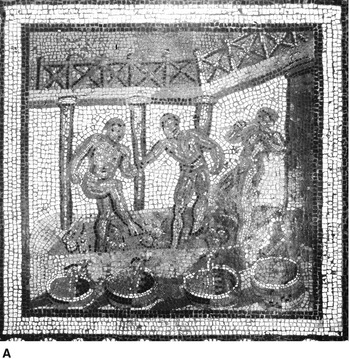
Figure 4.14A Three men treading grapes with juice flowing into containers, Saint-Romain-en-Gal, detail of mosaic floor, now located in the Musée de Saint-Romain-en-Laye.
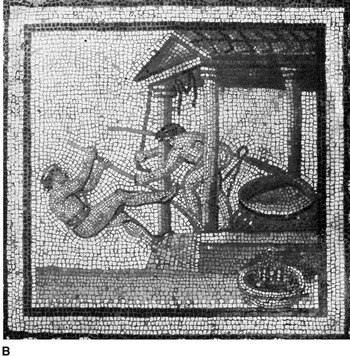
Figure 4.14B Two men pressing with simple lever press, Saint-Romain-en-Gal, detail of mosaic floor, now located in the Musée de Saint-Romain-en-Laye.

Figure 4.14C Worker cleaning storage jar while another stirs pitch, Saint-Romain-en-Gal, detail of mosaic floor, now located in the Musée de Saint-Romain-en-Laye.
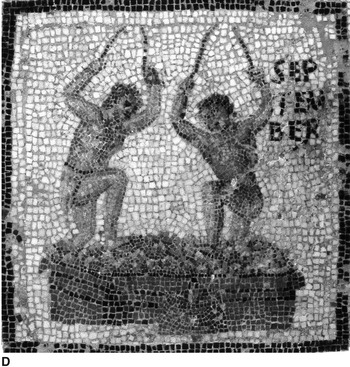
Figure 4.14D Two workers treading grapes, El Jem, Tunisia, September in calendar mosaic.
According to Pliny, during his day a vine was discovered at Viviers in the province of Narbonensis that was extremely immune to bad weather, and that was now grown throughout the province.63 The importance of Beziers’ wine did not extend outside the Gallic provinces. Massilia had two types of wine, but Pliny had no use for the rest of the wines of Gallia Narbonensis, for they were adulterated by smoking and the addition of noxious herbs and drugs.64
Archaeobotanical evidence attests the presence of viticulture during the Hellenistic period at Marseilles, where the archaeological remains of vineyards have been recorded in a field near St. Jean du Désert.65 There is also evidence from the Villa des Tuillières near Selongey in Gaul (Côte d’Or, France).66 And at the villa of Selongey and most probably also at the villa of the Tête de Fer near Grimault-Noyers-sur-Serein (Yonne, France) a pressing building was part of the pars urbana (residence). Furthermore, a destruction layer of the villa of Selongey, dated around AD 250, contained hundreds of carbonized pips from cultivated grape. Palynological evidence of viticulture, indicated by a continuous pollen curve with values around 3 percent, is known from Neublans (Jura, France), situated at the foothills of the French Jura Mountains.67
Germania Superior
In the province of Germania Superior, “where the climate was suitable, for example on the Moselle and the Neckar, viticulture was practiced.”68 Domitian’s edict restricting the cultivation of the vine does not seem to have had any lasting or even temporary effect. The fourth-century author Ausonius praises Moselle wine.69 The emperor Julian speaks of vines raised near Paris.70 Well known are several late Roman wine-pressing buildings from the middle Mosel Valley, near Trier, Germany, a region that is still today famous for its viticulture.71 Additionally, archaeobotanical analysis has given evidence of huge assemblages of Vitis pips.72 There is no evidence of vineyards in the lower Rhine region in Germany because the climate was too cold. But individual vines may have grown on the protected southern side of houses where grapes could ripen.
Pannonia
There is also evidence of vineyards in Hungary (Pannonia). Orsolya Dálnoki, who is studying Roman viticulture in this area, reports that while there are as yet no excavated sites, the archaeological evidence – for winepresses, viticulture tools, and carbonized grape pips, vine stems, and tendrils – indicates potential vine-growing areas in Roman times.73 The evidence was most plentiful in ancient Aquincum (Budapest) and environs. Material from a partially emptied well yielded 6,108 complete grape seeds (Figure 4.15), many thousands of fragments of plant seeds, as well as vine stems and tendrils. Fragments of wall paintings picture various aspects of viticulture (see Figures 16.13A–D) and four different types of grapes. Furthermore, viticulture tools were found at four sites in or near Aquincum, and at several other sites.74 This evidence, dating from the third to the fourth centuries, indicates that viticulture was well established at this time, especially at Aquincum and along the Danube. Strabo, writing in the middle of the first century BC, reported that the Illyrians imported wine and olive oil by sea in wooden barrels. Local wines, if they existed at that time, would have been limited. The historian Dio Cassius, proconsul in Dalmatia and Pannonia Superiore, writing in the early third century, said the Pannonian people who lived near Dalmatia, along the Danube shore, from Noricum to Moesia had neither oil nor wine except in small amounts, and it was negligible for its quantity and quality, for they lived in never-ending cold winter.75 Many authors, however, refer to the definite changes that took place during the reign of the emperor Probus (AD 276–82), who rescinded Aurelian’s order to reduce the number of vineyards in Gaul Pannonias and Moesia, and had his soldiers plant vineyards on Mt. Alma near Sirmium.76
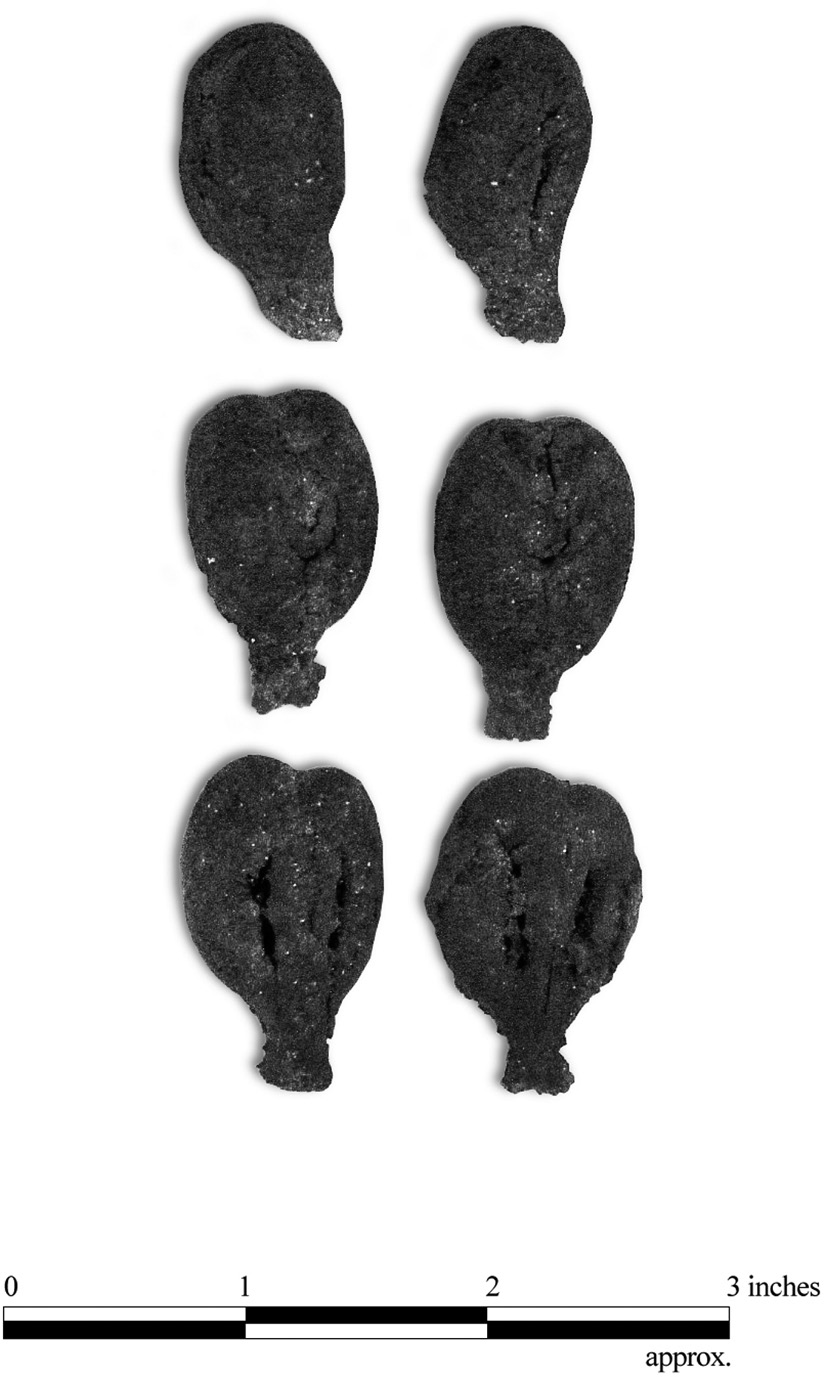
Figure 4.15 Carbonized grape seeds found in a well in ancient Aquicum (Budapest).
Britannia
Evidence for viticulture in Britannia is mentioned in the ancient texts, and the archaeological picture continues to emerge. A considerable number of vine stems were found in the villa at Boxmoor, Hertfordshire, on a sheltered slope facing west and south.77 In 1967, excavated remains tentatively identified as those of a vineyard were reported at North Thoresby, Lincolnshire.78 David Williams assessed the limited evidence, finding that if viticulture was practiced in Britain, it was on a small scale.79 More recently, however, a convincing case has been made for the successful and extensive cultivation of grapes by the second and third century AD, if not earlier, based on the discovery of remains of a vineyard at Wollaston, Nene Valley in Northamptonshire.80 The combination of the stratigraphic excavation and palynological study of Roman-era remains, together with the discovery of suitable pruning tools, have resulted in a reappraisal of the scale of grape production in Britain.
Achaea
Most parts of Greece produced wine, not as an article of export, but rather for local consumption. Likewise, many wines produced throughout the province of Asia were for local consumption, but they also had many famous wines that were exported. According to Pliny the Elder, the island wines were highly regarded, including those of Chios, Lesbos, Cos, and Rhodes, but various Lydian and Carian wines were also favored.81 Actual remains of vineyards have yet to be discovered, although the agricultural terracing required for growing grapes, olives, and other crops has been the subject of archaeological study in recent years.82
Syria and Palestine
There were many vineyards in Syria, and by the second millennium BC, Syrian wines were imported by all countries of the ancient world. Diodorus Siculus, writing in the first century BC, notes that in his day Syrian wines were exported to North Africa, Arabia, East Africa, India, and Spain. There is as yet, however, no reported evidence for the archaeological remains of a vineyard.
Finds of grape pips in the excavations at Jericho indicate that viticulture in Palestine dates back to at least the third millennium BC. Within Palestine, the ancient sources portray Judaea as the main area for vineyards, while Galilee was noted for its olives.83 However, there is abundant textual and archaeological evidence for grape production throughout the region. Ancient rabbinic sources make it clear that the primary economic value of grapes was for wine production and those produced in the Carmel Mountains were favored in antiquity as they are today. The archaeological evidence for wine production generally takes the form of pressing vats, towers, and amphorae, as well as agricultural terracing. Grape pips are commonly found as mineralized and macro-remains in Roman period assemblages (see Chapter 16). In most instances, they attest to the popularity of fresh or dried grapes for eating as well as for wine making.
Africa
The Greek papyri from Egypt give us considerable information about the vineyards in Egypt. The papyri document the taxes both in money and in kind. Vineyards, ampeloi (ἀμπελῶνες), appear in these texts more often than any other non-arable type of cultivation.84
African wine was rarely attested in the classical texts before the Empire. The Carthaginians had produced wine, but it was supposedly of inferior quality and quantity.85 Even under the Romans, grapes were always a minor crop compared to grain. There is little information in the sources regarding the production of wine, but the areas not too far from the sea are well suited to the vine.86 There were commercial corporations of wine merchants (collegium vinariorum) and sellers (oenopolae) at Carthage.87 Columella was acquainted with Mago’s work, whose Latin translation – ordered by the Roman Senate – likely served Italians living in the arid regions of Africa, who were not used to the dry-farming techniques required in this part of the empire.88
Mosaics from Africa give valuable information about agricultural activities. An early fourth-century mosaic from Tabarka (Thabraca) in Tunisia, now in the Bardo Museum in Tunis, shows a vineyard surrounding a farm building, the vines trained on tiered frames (Figure 4.16). Olive trees are planted throughout the vineyard.
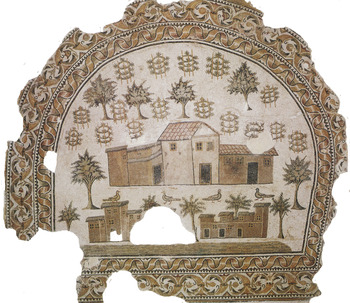
Figure 4.16 Vineyard in olive orchard surrounding a farmhouse, mosaic from Tabarka, Tunisia, now in the Bardo Museum.
An early third-century wall mosaic from Cherchel, now in the Cherchel Museum, shows the winter hoeing of a vineyard, whose vines are staked in a method used for free-growing varieties, known as vitis characata. Such vines, according to Columella, are trained around “canes fixed in the ground and … bent into loops and circles through props of reeds to which wood branches are tied.”89 But, this method was not the usual one for vine training in the provinces because Columella indicates that the most ubiquitous were vines “resembling small trees and standing by themselves on a short stock without any support.”
Orchards
Italy produced fruit in such profusion that Varro said the whole peninsula seemed to be one orchard (pomarium).90 The late Republic, from Sulla to Augustus, “was a period of profitable experimentation in fruit raising,” which gave a respite to soil exhausted by cereals.91 Roman generals, who owned large estates, were anxious to find and bring back to Italy new varieties of fruit, which they planted at their villas. Strabo, writing in the Augustan period, reports fruit trees in many parts of Italy, the hills around the Po Valley,92 Pisenum,93 Latium,94 and Capua, which he describes as the richest fruit land.95 Columella could say that Italy “has learned to produce the fruits of almost the entire world” through the zeal of her husbandmen.96 But, for orchards in the countryside of Italy we are dependent largely on the written sources; although one has been identified at the villa of Settefinestre.97 Furthermore, pomaria (orchards) are among the various types of tomb gardens known from inscriptions, especially in the vicinity of Rome.98
Pompeii was famous for its fruit and nuts. The Pompeians made room for a few fruit trees even in a small house garden, but there is a large commercial fruit orchard within the city walls at Pompeii (I.22).99 About half of the excavated area yielded some 150 tree cavities, approximately 2 to 3 meters apart and arranged in rows.100 About 90 percent had been small trees, which is characteristic of commercial orchards in the area today. We reached the northern limit of the orchard where we uncovered a wall with a cistern directly in front of it. The cistern probably collected rain from the roof of the house (most of which is still unexcavated) and provided the water so necessary in establishing a young orchard. The rainfall in the Pompeii area is barely adequate for orchard trees and extra water is always necessary for young trees not yet established. It is quite possible that the path that led to the triclinium could have served as an irrigation channel, as we have found in other gardens. Water from the cistern could then be channeled into the orchard, as needed.
The triclinium was shaded not by a vine-covered pergola, but by the spreading branches of three large trees (Figure 4.17). According to Carlo Fideghelli of the Istituto Frutticoltura in Rome, the tree roots at the southeast corner lend the appearance of an olive at least 30 years old. High values of olive pollen were indeed recorded from this garden, confirming Fideghelli’s identification and suggesting that the other two trees were also olive. It is clear they were growing in this insula many years before the younger trees had been planted.101 An altar in front of the triclinium is similar to painted examples on lararia, which depict sacrifices taking place outdoors on a freestanding altar set amid trees. The offerings made to the deities were normally modest, but the garden would be the natural place for a burnt, and certainly for a blood, offering.
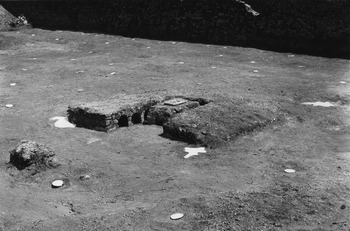
Figure 4.17 Altar and triclinium in large orchard I.21, Pompeii.
Columella gives detailed instructions for planting and maintaining an orchard, recommending that trees should be planted 3 to 4 meters apart in order to give ample space for the growth of mature trees and for crops to be planted underneath.102 In our orchard the trees were 2 to 3 meters apart, but again, the soil is very rich. There is no way to know if there was intercultivation in this orchard, for in the original excavation all the topsoil had been removed. This destruction eliminated the possibility of finding carbonized vegetables or fruits, such as were discovered in other gardens.
An orchard would normally include both fruit trees and nut trees. Fideghelli suggested that the two large clusters of root cavities in the southeast corner of the orchard were clumps of small trees, perhaps filberts, whose suckers had been allowed to grow, such as in present-day orchards. He had tentatively identified a similar clump in the garden of the House of the Ship Europa as filberts, where indeed later carbonized filberts were found. What were the other trees in this orchard? At Pompeii they were acquainted with the apple, pear, plum, fig, quince, sorb apple, peach, the cherry, and the lemon. They also knew the almond, filbert or hazelnut, walnut, and chestnut. The chestnut, however, was usually a forest tree. Pompeians could well have known, of course, other trees not yet recorded archaeologically in the city.
The hazelnut is indigenous to the Pompeii area and abundant on the lower slopes of Vesuvius. One of the Latin names of the hazelnut, abellana, takes its name from Abella, a town to the north of Vesuvius famous for its nut and fruit trees.103 The Herculaneum fig takes its name from one of the Vesuvian cities, just as the modern American and little Greek apples are named from their places of origin.104 By Pliny’s time there were many varieties of species, some named for those who were said to have produced them by grafting.105
Mattingly, in his comprehensive treatment of the olive in antiquity, discusses in detail the evidence for many olive orchards in the Roman Empire. For example, he describes excavations in the southern Italian village of Passo di Corvo in Apulia, where planting pits of the trees of an olive orchard were uncovered above a Neolithic settlement.106 Aerial photographs, taken by Bradford in Apulia, reveal planting pits in a layout suggesting olive orchards.107 Other photos taken by the French in Tunisia during the Second World War similarly revealed tree pits of many olive orchards.108 These orchards, which Bradford believed were predominately olive, occupied over 60 percent of the ground area. The regularity of these orchards indicates they were created from nursery-propagated stock, not cuttings grafted onto existing wild olive trees. Bradford also reports the substantial evidence, furnished by the remains of olive mills and presses, for extensive olive orchards; the great size of these presses indicates their capacity to process crops of large commercial orchards. From a survey of remains of these presses, especially in central Tunisia and western Libya (ancient Tripolitana), it has been possible to estimate the scale of oil production.109 Palaeobotanical remains in wadi beds in Tunisia indicate that by a simple but ingenious system of floodwater management the ancient farmers were able to cultivate vineyards and olive orchards.110
When orchards were planted in the provinces, special care was taken, as in the case of the vine, to plant varieties that were adapted to the local soil, climate, and exposure. The olive, with its many slightly different varieties, had the capacity to produce in marginal areas, including arid-zone environments, where other crops could not be raised.111
We have numerous references in the literary sources to fruits or nuts produced in the provinces; there is, however, only limited evidence about the orchards in which they would have been grown. A rare example is the villa of Selongey in Gaul, where there is archaeobotanical evidence for fruit trees.112 We have no archaeological information about orchards in the Spanish provinces, but the ancient authors mention various fruits grown there. Knörzer, analyzing soil samples rich in plant remains from wells, latrines, and refuse pits in the lower Rhine region, was able to identify eleven species that were grown in orchards.113 Dickson, analyzing soil samples from disused wells, latrines, and cesspits in British sites, found evidence of only three or four fruit species and the walnut, which could have been grown in orchards.114
Sicily had long been a country planted with gardens and orchards. According to Diodorus,115 the entire countryside around Syracuse was beautiful with fruit-bearing trees; Panhormus, Solus, and Halyeiae were surrounded with orchards. Gelon’s villa was famous for its orchards, flowerbeds, and system of irrigation.116 The Sicilians were so fond of gardens that Hiero built one on his famous ship and even published a book on gardening.117 As a Roman province, Sicily continued this tradition with orchards of all the fruits that grew in a Mediterranean climate. Athenaeus specifically mentions almonds, apples, plums, quinces, and walnuts.118 Sicilian quinces were valued abroad for their medicinal use.119
The only reference to an orchard in Greece is the small grove of fruit-bearing trees in the Sanctuary of the Nymphs in the mountain town of Kyrtones.120 The traveler Pausanias speaks of groves of fruit trees at temples he visited.121 The Talmud speaks of the value of orchards in Syria, where fruit and date orchards were even more profitable than vineyards.122 We fortunately have information, which comes for the most part from Greek papyri, about orchards in Egypt, although this evidence is limited because it is concerned with the assessment and collection of taxes on agricultural land. The papyri do not use the Latin word pomarium, but instead the Greek paradeisos (παράδεισος), to denote an orchard, which included date palms and olives. Unlike in Greece, in Egypt olives were grown in walled gardens. Fruit and nuts raised in Egypt include the date palm, persea, fig, olive, apple, pomegranate, peach, pear, citron, cerob, sebesten, jujube, nuts (walnuts, hazelnuts, chestnut, and almond), pistachio, quince, and apricot, and among the examples of gardens that Bagnall describes is an orchard (paradeisos) in the suburbs of Arsinoë, leased to an orchard-man (pomarius), in which part of the rent was paid in produce, which included figs, citron, pomegranates, and peaches.123 In Upper Egypt, a temple garden known from an inscription in verse by the owner mentions the persea and date palms.124
Although there is some archaeological evidence, as in Britain and the lower Rhine, and more plentiful literary evidence for the production of fruit in the provinces, the archaeological evidence for the actual location of the orchards where the fruit was raised, as we have seen, is largely lacking. But again, mosaics reflect the importance of fruit production. One panel in a mosaic from Saint-Romain-en-Gal shows workers harvesting fruit (Figure 16.16B). Many mosaics in Africa feature the various fruits raised there (for an example, see Figure 12.15). The literary evidence from Egypt is unique in providing the location and size of specific orchards and the fruits raised in them.
Flower Gardens
We have seen that flowers, an integral part of the kitchen garden, would supply the needs of the household, and if raised on a villa near a town, could be sold to townsmen for profit. We have evidence also of large commercial flower gardens, one of which I excavated at Pompeii in the Garden of Hercules (II.8.6: Figure 4.18). Most of the garden had been previously excavated, but there were areas in which the original lapilli had been left to a sufficient height to preserve the ancient soil contours and root cavities. We found complicated soil contours that divided the garden into many beds, unlike anything I had found up to that time in the Vesuvian area. Under a large pile of original lapilli, we found a perfectly preserved bed in which, after a rain, we discovered round formations; in the center of each there had been a very small plant, but it was too small for the lapilli to have trickled into it to preserve the root cavity (Figure 4.19). Around each little plant was a depression for water. As we continued to clear the garden, we found evidence of other beds.
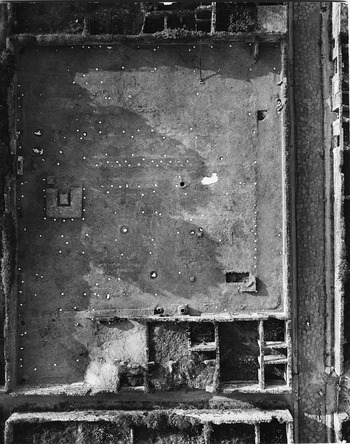
Figure 4.18 Garden of Hercules, II.8.6, Pompeii, aerial balloon photograph, after Jashemski Reference Jashemski1979, fig. 421.
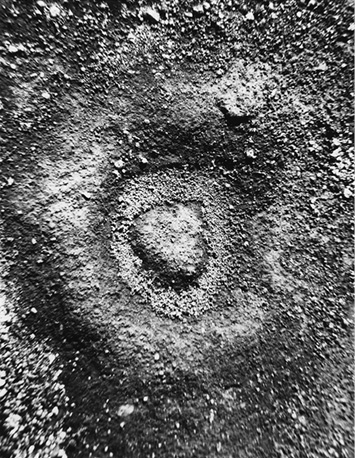
Figure 4.19 Soil shaping, Garden of Hercules, II.8.6, Pompeii.
Rainwater from the roof of the house was collected into large earthenware containers (dolia) flanking the door leading into the garden; a channel then carried this water to a nearby pool. Additional water had to be carried in, for the aqueduct did not reach this part of the city. This water was poured directly from the street through an amphora tip inserted in the east end of the north wall to fill a dolium inside the house (Figure 4.20). Soil contours showed how water was led along the east wall of the garden, watering trees growing in a channel and also along the south and west walls. Water from these channels, as well as water from the pool and a cistern, was directed into other channels that divided the garden into wide beds. Aerial photographs clearly show the pattern of the root and stake cavities, and in a remarkable way reveal even badly damaged soil contours that are not visible from the ground (Figure 4.18). The beds were not all on the same level: those on the north were slightly higher than those on the south, thus conforming to the natural slope of the land. To ensure the flow of water from the higher to the lower levels the water channels on the north were placed higher than the beds, those on the south lower. The modern Pompeian shapes his planting beds in much the same way, although the height of the modern beds is sometimes much greater than in this ancient garden (Figure 4.21).

Figure 4.20 Amphora neck inserted in street wall, Pompeii, to fill large dolium.
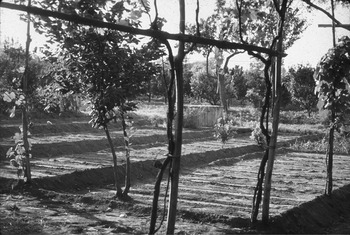
Figure 4.21 Modern garden with terraced levels, Pompeii.
In this garden there were relatively few trees but many stakes used to shade young plants, as is still the practice today. The many nails found in the garden probably came from the frames. The stakes for shading and the carefully watered beds make it certain that either flowers or vegetables were grown; probably both at different seasons. There is, in fact, good reason to believe that this garden was a commercial flower garden for at least part of the year.
Flowers were in great demand in ancient Pompeii, but the Romans did not use them in bouquets as we do, but for garlands and crowns that were much in demand for festivals, banquets, birthdays, weddings, games, and funerals. A garland was the proper gift to honor not only the gods but also the living and the dead. Cupids and Psyches are frequently pictured in wall paintings engaged in human activities. Rostovseff believed that such wall paintings depicted businesses in which the householder was engaged. Thus, images of Cupids and Psyches gathering flowers and making garlands and crowns reflect the importance of this activity – best represented in the painting of flower dealers from the House of the Vettii (Figure 4.22). At the right a gardener brings flowers to market on the back of a goat; a small boy trudges behind, his basket filled with flowers. Cupids make garlands that are displayed on wooden racks, from which a customer, at the far left, is making a selection. Because of these images Della Corte believed that the Vettii raised flowers commercially on their farms; other paintings referring to the wine trade suggest the same for grapes. A similar image of flower dealers in the House of the Calpurnii (VII.7.2/15), excavated before the days of photographic records, is fortunately known from a drawing made before the painting disappeared (Figure 4.23A). A painting in the Macellum, also preserved in a drawing, shows Cupids and Psyches hanging garlands on their donkeys that turned the mills, as they celebrate the Vestalia, the festival of Vesta, the patron goddess of bakers (Figure 4.23B).
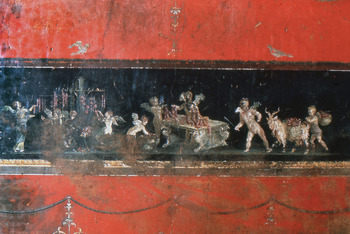
Figure 4.22 House of the Vettii, IV.15.1, Pompeii, Cupids and Psyches gathering flowers.
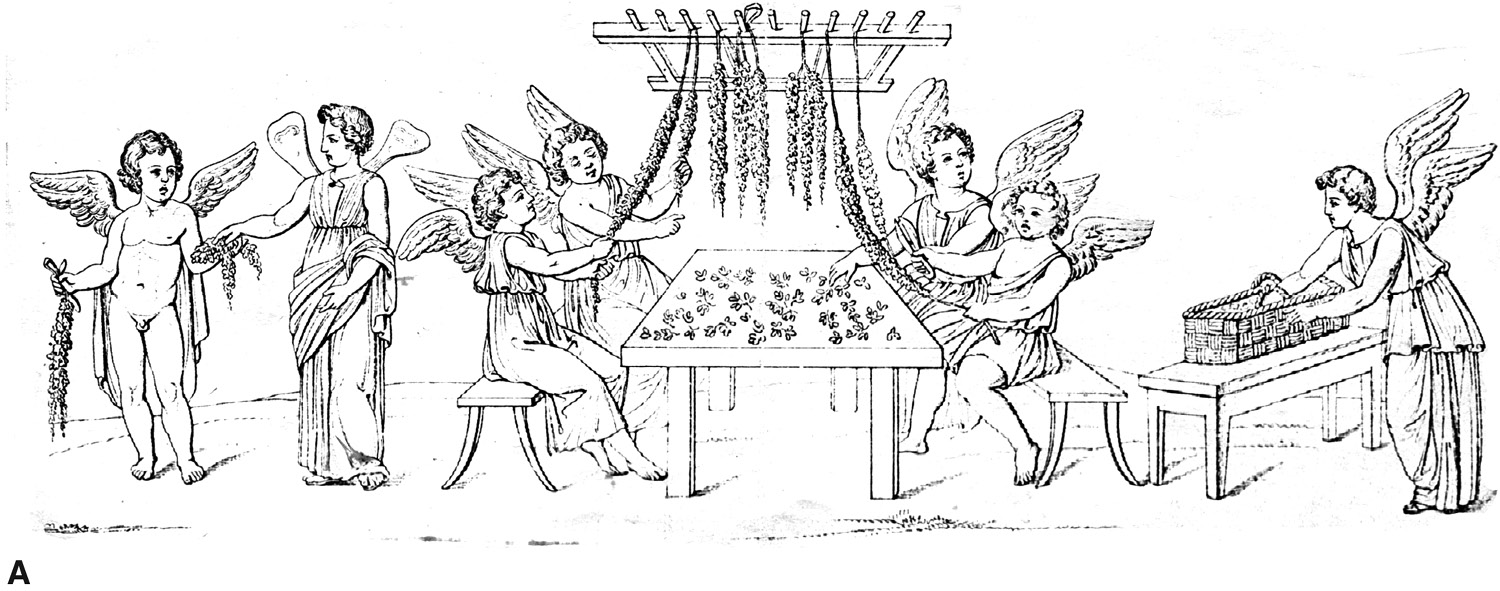
Figure 4.23A Macellum, VII.9.7/8,19,42, Pompeii, flower dealer, fresco, after Fausto and Felice Niccolini, Le case ed i monumenti di Pompei disegnati e descritti (4 vols., 1854–97), Vol. I, Part I; 2, pl. 4.

Figure 4.23B Macellum, VII.9.7/8,19,42, Pompeii, Cupids and Psyches hang garlands on donkeys that turn a mill, fresco, after Fausto and Felice Niccolini, Le case ed i monumenti di Pompei disegnati e descritti (4 vols., 1854–97), Vol. I, Part I; 2, pl. 4.
There was a thriving business of garlands and wreaths at Pompeii. Many wall paintings show garlands used as decorations in houses and shops, even the forum. Garland sellers were probably among those who set up portable stands on market days in the forum or on one of the main streets of Pompeii.
Many flowers were also used for making perfume and unguents. A large number of perfume bottles (Figure 4.24) were found in the house connected with the Garden of Hercules and we found, surprisingly, many fragments of perfume bottles in the garden. The discovery of a large tree root cavity in this garden, identified by Prof. Fideghelli as that of an olive, reminds us that olive oil was an important base used in making perfume and unguents. One of the largest commercial flower growers in modern Pompeii told me that the soil contours and cavities in the Garden of Hercules definitely indicated flower culture; he grows his flowers in the same kind of plots today. Flowers are also raised commercially in the Pompeii area today for cut flowers.
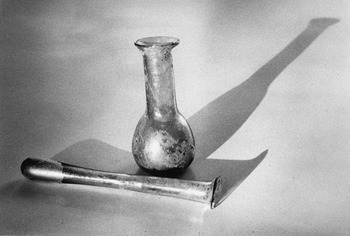
Figure 4.24 Perfume bottle found in Garden of Hercules, II.8.6, Pompeii.
The partly excavated maritime villa of Sinuessa in Campania, near modern Mondragone, has a garden built on at least four terraces, the lower one ending just a few meters from the present shore line. Elaborate care had been taken to bring in good soil for this garden and to provide for its irrigation; sophisticated measures were used to insure protection from underground salt water, due to its nearness to the sea.125 The excavators suggest that flowers might have been raised commercially in the garden, consistent with the suggestion of Cato, who advised that if a villa was near a town, flowers could be a very profitable crop.126
No other flower gardens have been excavated in Italy, but recent archaeological evidence led to the identification of a small shop in the forum of Paestum as a perfumery, where the pressing of the oil and the making of perfume took place.127 Wall paintings of unguentarii (perfume dealers) in, for example, the House of the Vettii (Figure 4.25) and the House of the Calpurnii at Pompeii and at houses in Herculaneum, show that the making of perfume was done in the presence of customers. A wall painting from Pompeii (provenience unknown), now in the Fitzwilliam Museum in Cambridge, England, shows Cupids working a small vertical press, certainly pressing oil for perfume (Figure 4.26). Such a press has been found at Pompeii (Figure 4.27). Vergil, Propertius, Martial, and Ovid speak of the fame of the roses and the perfume of Paestum. We learn from literature and inscriptions that Praeneste and Capua were also centers of the perfume industry. In Capua there was a street of the unguentarii, where the perfumers had their shops. Pliny says that Egypt, of all the countries in the world, was best adapted for the production of unguents, but Campania was a close second.128
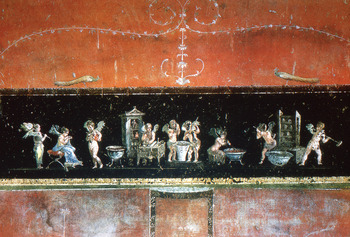
Figure 4.25 House of the Vettii, IV.15.1, Pompeii, perfume dealers, fresco.
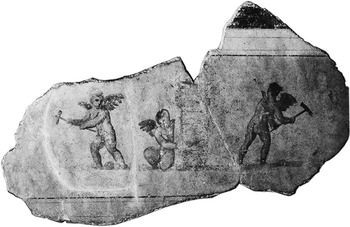
Figure 4.26 Cupids pressing flowers, Pompeii, Fitzwilliam Museum, Cambridge, England.
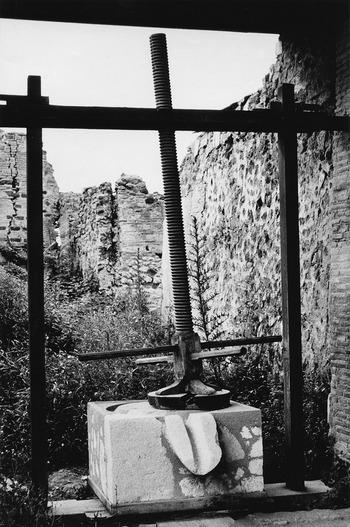
Figure 4.27 Reconstructed vertical oil press at Pompeii, VII.7.
It is not surprising that we have knowledge of actual flower gardens in Egypt. The leases of several rose gardens as well as that of a narcissus garden are recorded in Greek papyri, and it is clear that Madonna lilies were raised for perfume.129 Egypt, where flowers could be cultivated the year round, was also famous for its garlands; Martial speaks of winter roses from Egypt.130 The prize amaranth was grown in Egypt and it was used for winter garlands.131 Also mentioned by Pliny for garland flowers in Egypt are sweet marjoram, known in Egypt as samsucum, the white viola (stock), batis (sea fennel), tychnos or strychnos (the nightshade), and pesoluta.132 Bagnall also reports the presence of the laurel and myrtle in Egypt.133
Many flowers were raised in commercial flower gardens in Asia for perfumes and unguents. The iris was not used in garlands, but its root was highly prized for unguents, also for medicine; the best came from Pamphylia but the Cilician iris was highly praised.134 Syrian fenugreek oil was once considered the best.135 Literary sources document that different places around the Roman Empire were famous for particular flowers used for unguents. Inscriptions, more often tomb inscriptions, give evidence of the presence of unguentarii throughout the empire, in Gaul, Achaea, Dalmatia, Britain, and Africa. The evidence documenting the making of floral scented unguents indicates that flowers were grown commercially in many parts of the empire, although the actual gardens in which they were raised have not been located.
Wall paintings and mosaics from Rome and elsewhere throughout the Roman world attest the use of flowers for making garlands and crowns. Four lost wall paintings, found in 1704, on the ceiling of a burial chamber near the church of S. Stefano Rotondo in Rome, picture flower dealers, including a peddler, who carries his garlands on a curved pole. Inscriptions from Rome refer to garlands sold along the Sacred Way136 and to two freedmen, one of them a candle, the other a garland maker.137 In a mosaic from Algeria, a bountiful garland as a border in a mosaic is depicted with fruits as well as flowers, along with the bindings that hold them together (Figure 4.28). A mosaic from Desenzano, north of Rome, depicts two women making garlands; mosaics in Piazza Armerina in Sicily also portray this activity, as does a mosaic from Sousse, in Tunisia, acquired by the Boston Museum of Fine Arts.138 In the upper zone erotes are picking flowers that are clearly roses in a garden enclosed by a lattice fence (Figure 4.29). In the lower zone of the Boston mosaic, reading from right to left, the roses are brought to the workers, who make them into garlands, which are displayed for sale on a pole by a peddler. Many such commercial flower gardens would have been needed to supply the need for flowers in the Roman Empire.

Figure 4.28 Garland border from the wedding of Thetis, Choba, Bejaia, Algeria.
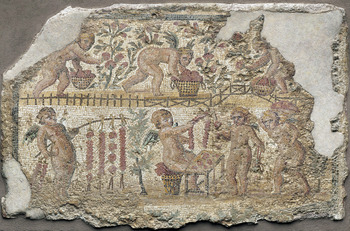
Figure 4.29 Cupids gathering roses, Sousse, Tunisia, mosaic, Museum of Fine Arts, Boston.
Conclusions
So far, four broad types of produce gardens can be identified among the Romans: kitchen gardens, vineyards, orchards, and commercial flower gardens. As far as the evidence is preserved, all are found throughout the empire, limited only by climate. Cato, Pliny, and Columella discuss the siting, planting, and cultivation of kitchen gardens. Pliny, fortunately, tells us that they should be near the house with a source of water close by. Evidence of kitchen gardens has been found in: Settefinistre, the lower Rhine region of Germany, Austria, Hungary, The Netherlands, and Egypt. Evidence of vineyards is found in Italy, Spain, France, Germany, and Hungary; of orchards, in Italy, Sicily, Germany, and Judaea. Finally, we should recognize the difficulty faced by archaeologists looking for evidence of ancient produce gardens throughout the empire because their size makes excavation expensive and difficult. Although the remains of water channels may indicate the presence of a large garden, orchard, or vineyard, preservation of the soil surfaces and plant remains is often poor, as deep plowing continues to destroy ancient soil contours, carbonized plant remains, and pollen. Nonetheless, at various sites today traditional planting practices and cultivation are responding to local cultivation conditions in similar ways, so it is valuable for archeologists to study present gardens in the places where ancient gardening has been identified.





































